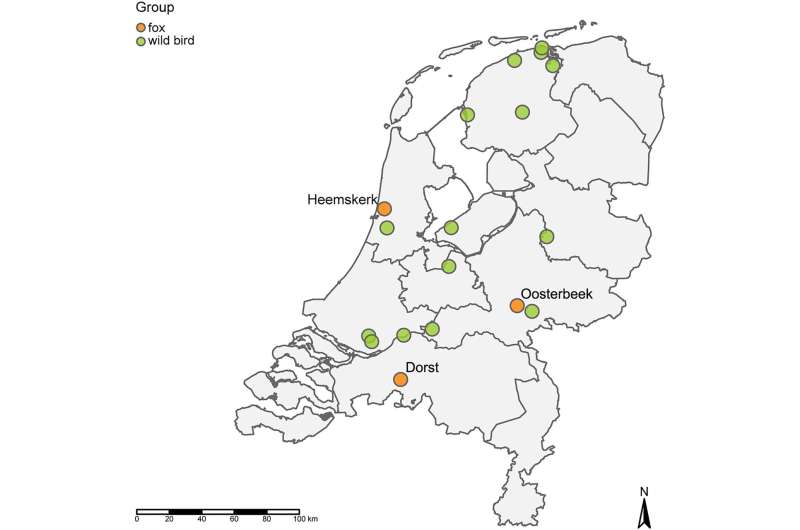This article has been reviewed according to Science X's editorial process and policies. Editors have highlighted the following attributes while ensuring the content's credibility:
fact-checked
trusted source
proofread
No spread of H5N1 bird flu between mammals found

Mammals can become infected with the highly pathogenic (HPAI) avian influenza H5N1 virus when they feed on infected sick or dead wild birds. Studies by Wageningen Bioveterinary Research (WBVR) show that there is no spread of the virus between the mammals. However, a zoönotic mutation was found. "That's a sign that the virus is adapting to a new host," says Nancy Beerens, head of the Dutch National Reference Laboratory Avian influenza.
In the winter of 2021–2022, there was a high mortality rate among wild birds due to bird flu in the Netherlands. That season, several foxes, polecats, an otter and a badger also became infected. The mammals were noticed for their abnormal behavior, with neurological symptoms. The animals were examined by Wageningen Bioveterinary Research (WBVR) for infection with the HPAI H5N1 virus. The virus was particularly detected in the brains of these animals, while swabs of throat, nose and rectum were often tested negative. This study shows that it is important to test brain samples of mammals that are suspected of HPAI infection.
No spread of bird flu between mammals
In different animals a zoonotic mutation (PB2-E627K) was detected in analysis of mammalian viruses. This allows the virus to multiply better in mammals. The mutation was not found in wild bird viruses. However, multiple mutations are needed before a virus can spread between mammals or to humans.
Recently, an HPAI H5N1 infection was detected at a mink farm in Spain, where there was possible spread of the virus between the animals. The mutations found on the farm were not detected in the wild mammals in WBVR's studies. "Genetic analysis of the wild mammalian viruses showed that they are not closely related. There is no evidence of spread of the virus between these mammals. The mammals have become infected independently of each other by eating infected wild birds," says virologist Nancy Beerens.
Vigilance required
It is important that mammals with abnormal behavior are reported so that they can be investigated for bird flu. At the moment, it is not obligatory in Europe to report mammals that are infected with HPAI H5N1 virus, so information on the number of infections is not centrally available.
"Setting up effective surveillance programs for wild mammals can provide more insight into the infections and the emergence of mutations," says Beerens. "From the One Health perspective, with respect to the risks for humans, it is important to monitor mammalian viruses for the emergence of mutations, and therefore to closely monitor infections of mammals."
The related research is published in Pathogens and Microbiology Spectrum.
More information: Sandra Vreman et al, Zoonotic Mutation of Highly Pathogenic Avian Influenza H5N1 Virus Identified in the Brain of Multiple Wild Carnivore Species, Pathogens (2023). DOI: 10.3390/pathogens12020168
Luca Bordes et al, Highly Pathogenic Avian Influenza H5N1 Virus Infections in Wild Red Foxes (Vulpes vulpes) Show Neurotropism and Adaptive Virus Mutations, Microbiology Spectrum (2023). DOI: 10.1128/spectrum.02867-22
Provided by Wageningen University



















